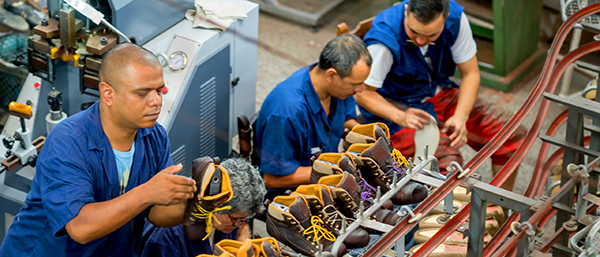Nearly half of Gen Z says their bosses don’t get AI. Manufacturers must act now to unlock AI’s full value.
In today’s rapidly evolving workplace, artificial intelligence (AI) is no longer a futuristic concept—it’s a present-day imperative. Yet, a growing divide is emerging between those who are ready to embrace AI and those who remain hesitant. At the heart of this divide lies a generational disconnect: Gen Z employees are charging ahead with AI adoption, while many of their managers are struggling to keep pace.
According to the latest research from UKG, nearly half (49%) of Gen Z employees believe their bosses don’t understand the benefits of AI. This sentiment is particularly striking in industries like manufacturing, where operational efficiency, workforce agility, and innovation are critical to staying competitive and retaining the next wave of talent. As the youngest generation in the workforce takes the lead in adopting AI tools, manufacturing leaders must recognize the opportunity—and the urgency—to close this gap.

The UKG AI Tasks Survey 2025 paints a compelling picture of a workforce eager for change. A staggering 84% of U.S. employees want AI to handle workplace processes for them, and 79% believe AI tools could free up time to focus on more meaningful work. Gen Z, in particular, stands out: 90% believe AI will save them time at work, with nearly a third expecting to reclaim up to 89 minutes per day.
What’s more, 70% of Gen Z employees have taught themselves the AI skills they use at work—compared to just 58% of Gen X and 40% of Boomers. This self-driven learning reflects a generation that not only sees the value of AI but is actively integrating it into their daily routines.
Yet, despite this enthusiasm, many Gen Z workers feel their efforts are misunderstood or undervalued. The perception that leadership doesn’t understand AI is more than a generational gripe—it’s a warning sign. If left unaddressed, this disconnect could hinder innovation, stall productivity gains, and create friction between frontline workers and decision-makers.
In manufacturing, where hierarchical structures and legacy systems often dominate, this gap can be especially pronounced. Leaders who fail to recognize the potential of AI—and the insights of their youngest employees—risk falling behind in an industry that’s already undergoing seismic shifts.
While the disconnect is real, so is the opportunity. AI isn’t just a tool for tech companies or digital startups—it has transformative potential for manufacturing environments, from the factory floor to the front office.
Imagine a production line where AI agents monitor equipment performance in real time, predict maintenance needs, and optimize workflows to reduce downtime. Picture HR systems that use generative AI to create personalized training plans, automate scheduling, and ensure accurate payroll processing. These aren’t distant dreams—they’re capabilities that exist today. By implementing AI into workflows, manufacturers can enhance their competitive capabilities while improving the employee experience for workers across generations.
The UKG survey highlights several tasks employees are ready to hand off to AI, including: summarizing company policies (83%); creating work schedules based on availability (81%); verifying paycheck accuracy and ensuring timecard accuracy (both 78%); and reviewing and approving time-off and shift-swap requests (74%).
For manufacturing leaders, these insights are a roadmap. By automating repetitive, data-intensive, and error-prone tasks, AI can free up valuable time for employees to focus on higher-value activities—whether that’s improving quality control, innovating new processes, or enhancing customer service.
Moreover, AI can help address some of the most pressing challenges in manufacturing today: labor shortages, skills gaps, and the need for greater flexibility. By augmenting human capabilities rather than replacing them, AI empowers workers at all levels to do their jobs more effectively and with greater satisfaction.
To harness the full potential of AI, manufacturing leaders must move beyond pilot programs and isolated use cases. They need a strategic, inclusive approach that brings the entire workforce along for the journey. Here are five best practices to guide the way:
1. Listen to Your Gen Z Employees
Gen Z isn’t just tech-savvy—they’re AI-native. They’ve grown up with intelligent systems and are often the first to experiment with new tools. Rather than dismissing their enthusiasm, tap into it. Create forums where younger employees can share their experiences, suggest use cases, and even lead training sessions for their peers and managers.
In manufacturing settings, this might mean inviting Gen Z workers to participate in digital transformation initiatives or serve as AI ambassadors on the shop floor.
2. Focus on Augmentation, Not Replacement
One of the most consistent findings in the UKG survey is that employees want AI to support—not replace—their work. This is especially true in manufacturing, where human judgment, craftsmanship, and problem-solving remain irreplaceable.
Frame AI as a co-pilot, not a competitor. Emphasize how it can reduce manual workloads, minimize errors, and enhance decision-making. For example, AI can analyze production data to identify inefficiencies, but it’s the human operator who interprets the insights and takes action.
3. Prioritize Transparency and Trust
Trust is the foundation of successful AI adoption. Employees need to understand how AI systems work, what data they use, and how decisions are made. This is particularly important in manufacturing environments where safety, compliance, and accountability are paramount.
Be transparent about your AI strategy. Communicate clearly about what tasks AI will handle, how it will impact roles, and what safeguards are in place. Involve employees in the design and implementation process to build buy-in and reduce resistance.
4. Invest in Training and Upskilling
While Gen Z may be self-taught, not everyone learns the same way. To ensure equitable access to AI’s benefits, provide structured training programs that cater to different learning styles and experience levels.
In manufacturing, this could include hands-on workshops, digital simulations, or peer mentoring programs. Focus on practical applications—how to use AI tools to streamline workflows, improve quality, or enhance safety.
5. Align AI with Business and People Goals
AI should never be a solution in search of a problem. Start with your business objectives—whether that’s reducing downtime, improving throughput, or enhancing employee engagement—and identify how AI can help achieve them.
At the same time, consider your people goals. How can AI make work more meaningful, flexible, and fulfilling? How can it support diversity, equity, and inclusion? By aligning AI initiatives with both business and human outcomes, you’ll create a more resilient and future-ready organization.
The message from Gen Z is clear: AI is here, it’s powerful, and it’s time to take it seriously. But this isn’t just a generational issue—it’s a leadership opportunity. By embracing AI and empowering employees across all age groups, manufacturing leaders can unlock new levels of productivity, innovation, and engagement.
The path forward isn’t about choosing between people and technology. It’s about bringing them together to build a better, smarter, and more human workplace. And in that future, everyone—Gen Z included—has a vital role to play.

About the Author:
Emory Lane is the Senior Industry Principal for Manufacturing at UKG, where he helps global manufacturers harness the power of AI, workforce intelligence, and operational excellence to drive transformation. With over three decades of executive leadership at Mohawk Industries, Emory has led enterprise-wide lean initiatives, MES implementations, and digital transformation strategies across complex manufacturing environments. A recognized champion of continuous improvement and data-driven decision-making, Emory brings a unique blend of engineering expertise and people-first leadership to the evolving future of work.
In this episode, I sat down with Beejan Giga, Director | Partner and Caleb Emerson, Senior Results Manager at Carpedia International. We discussed the insights behind their recent Industry Today article, “Thinking Three Moves Ahead” and together we explored how manufacturers can plan more strategically, align with their suppliers, and build the operational discipline needed to support intentional, sustainable growth. It was a conversation packed with practical perspectives on navigating a fast-changing industry landscape.